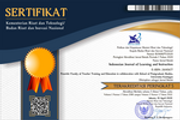REVOLUTIONIZING BIOLOGY LEARNING THROUGH AR: THE CASE OF LEAFCAPTURE APPLICATION DEVELOPMENT
Abstract
Full Text:
PDFReferences
Amin, M., Shah, B., Sharif, A., Ali, T., Kim, K. Il, & Anwar, S. (2022). Android malware detection through generative adversarial networks. Transactions on Emerging Telecommunications Technologies, 33(2). https://doi.org/10.1002/ett.3675
Ara, J., Bhuiyan, H., Bhuiyan, Y. A., & Bhyan, S. B. (2021). AR-based modern healthcare : A review. ArXiv Cornell University.
Baragash, R. S., Aldowah, H., & Ghazal, S. (2022). Virtual and augmented reality applications to improve older adults’ quality of life: A systematic mapping review and future directions. In Digital Health (Vol. 8). https://doi.org/10.1177/20552076221132099
Beghin, T., Cope, J. S., Remagnino, P., & Barman, S. (2010). Shape and texture based plant leaf classification. Lecture Notes in Computer Science (Including Subseries Lecture Notes in Artificial Intelligence and Lecture Notes in Bioinformatics), 6475 LNCS(PART 2). https://doi.org/10.1007/978-3-642-17691-3_32
Bellalouna, F., Langebach, R., Stamer, V., & Zipperling, F. (2022). Use Cases für industrielle Anwendungen der Augmented Reality Technologie. HMD Praxis Der Wirtschaftsinformatik, 59(1). https://doi.org/10.1365/s40702-021-00824-x
Billinghurst, M., Clark, A., & Lee, G. (2014). A survey of augmented reality. In Foundations and Trends in Human-Computer Interaction (Vol. 8, Issues 2–3). https://doi.org/10.1561/1100000049
Boboc, R. G., Băutu, E., Gîrbacia, F., Popovici, N., & Popovici, D. M. (2022). Augmented Reality in cultural heritage: An overview of the last decade of applications. In Applied Sciences (Switzerland) (Vol. 12, Issue 19). https://doi.org/10.3390/app12199859
Definitions and Applications of Augmented/Virtual Reality: A Survey. (2021). International Journal of Emerging Trends in Engineering Research, 9(3). https://doi.org/10.30534/ijeter/2021/21932021
Desai, U., Kamath, S., Shetty, A. D., & Prabhu, M. S. (2022). Computer-aided detection for early detection of lung cancer using CT images. Lecture Notes in Networks and Systems, 213. https://doi.org/10.1007/978-981-16-2422-3_24
Dewi, W., & Utomo, W. H. (2021). Plant classification based on leaf edges and leaf morphological veins using wavelet convolutional neural network. Applied Computer Science, 17(1). https://doi.org/10.35784/acs-2021-08
Dick, E. (2021). Balancing user privacy and innovation in augmented and virtual reality. Information Technology Innovation Foundation, March.
Elfrida, Tarigan, N. S., & Suwardi, A. B. (2021). Ethnobotanical study of medicinal plants used by community in Jambur Labu village, East Aceh, Indonesia. Biodiversitas, 22(7), 2893–2900. https://doi.org/10.13057/biodiv/d220741
Hidayat, T., & Ramadona Nilawati, A. (2018). Identification of plant types by leaf textures based on the backpropagation neural network. International Journal of Electrical and Computer Engineering (IJECE), 8(6). https://doi.org/10.11591/ijece.v8i6.pp5389-5398
Huixian, J. (2020). The analysis of plants image recognition based on deep learning and artificial neural network. IEEE Access, 8. https://doi.org/10.1109/ACCESS.2020.2986946
Lodico, M. G., Spaulding, D. T., & Voegtle, K. H. (2010). Methods in educational research: from theory to practice. Research Methods for the Social Sciences Ser.
Mahenthiran, N., Sittampalam, H., Yogarajah, S., Jeyarajah, S., Chandrasiri, S., & Kugathasan, A. (2021). Smart pest management: an augmented reality-based approach for an organic cultivation. 2nd International Informatics and Software Engineering Conference, IISEC 2021. https://doi.org/10.1109/IISEC54230.2021.9672432
Muhammad, I., Marchy, F., Rusyid, H. K., & Dasari, D. (2022). Analisis Bibliometrik: Penelitian augmented reality dalam pendidikan matematika. JIPM (Jurnal Ilmiah Pendidikan Matematika), 11(1), 141. https://doi.org/10.25273/jipm.v11i1.13818
Navia, Z. I., Audira, D., Afifah, N., Turnip, K., Nuraini, & Suwardi, A. B. (2020). Ethnobotanical investigation of spice and condiment plants used by the taming tribe in Aceh, Indonesia. Biodiversitas, 21(10), 4467–4473. https://doi.org/10.13057/biodiv/d211001
Park, B. J., Hunt, S. J., Martin, C., Nadolski, G. J., Wood, B. J., & Gade, T. P. (2020). Augmented and mixed reality: technologies for enhancing the future of IR. In Journal of Vascular and Interventional Radiology (Vol. 31, Issue 7). https://doi.org/10.1016/j.jvir.2019.09.020
Schäfer, A., Reis, G., & Stricker, D. (2022). A survey on synchronous augmented, virtual, andmixed reality remote collaboration systems. ACM Computing Surveys, 55(6). https://doi.org/10.1145/3533376
Subositi, D., & Wahyono, S. (2019). Study of the genus curcuma in Indonesia used as traditional herbal medicines. Biodiversitas, 20(5), 1356–1361. https://doi.org/10.13057/biodiv/d200527
Supiandi, M. I., Mahanal, S., Zubaidah, S., Julung, H., & Ege, B. (2019). Ethnobotany of traditional medicinal plants used by dayak desa community in sintang, West Kalimantan, Indonesia. Biodiversitas, 20(5), 1264–1270. https://doi.org/10.13057/biodiv/d200516
Syawaludin, A., Gunarhadi, & Rintayati, P. (2019). Development of augmented reality-based interactive multimedia to improve critical thinking skills in science learning. International Journal of Instruction, 12(4). https://doi.org/10.29333/iji.2019.12421a
Utami, W. T. P., & Trisnani, N. (2021). Pengembangan dongeng berbasis augmented reality sebagai bahan literasi dalam masa pandemi. Taman Cendekia: Jurnal Pendidikan Ke-SD-An, 5(2). https://doi.org/10.30738/tc.v5i2.11080
Vilasini, M., & Ramamoorthy, P. (2020). CNN approaches for classification of Indian leaf species using smartphones. Computers, Materials and Continua, 62(3). https://doi.org/10.32604/cmc.2020.08857
Walvoord, D., Baum, K. G., Helguera, M., Krol, A., & Easton, R. (2008). Localization of fiducial skin markers in MR images using correlation pattern recognition for PET/MRI nonrigid breast image registration. Proceedings - Applied Imagery Pattern Recognition Workshop. https://doi.org/10.1109/AIPR.2008.4906474
Wang, X., & Dunston, P. S. (2019). A user-centered taxonomy for specifying mixed reality systems for aec industry. Electronic Journal of Information Technology in Construction, 16.
Zagorc, A., & Bernik, A. (2022). Influence of augmented reality on purchase intention. Lecture Notes in Networks and Systems, 506 LNNS. https://doi.org/10.1007/978-3-031-10461-9_24
Zhang, Y., Peng, J., Yuan, X., Zhang, L., Zhu, D., Hong, P., Wang, J., Liu, Q., & Liu, W. (2021). MFCIS: an automatic leaf-based identification pipeline for plant cultivars using deep learning and persistent homology. Horticulture Research, 8(1). https://doi.org/10.1038/s41438-021-00608-w
DOI: https://doi.org/10.25134/ijli.v7i1.9603
Refbacks
- There are currently no refbacks.
Copyright (c) 2024 Indonesian Journal of Learning and Instruction

This work is licensed under a Creative Commons Attribution-NonCommercial-ShareAlike 4.0 International License.

